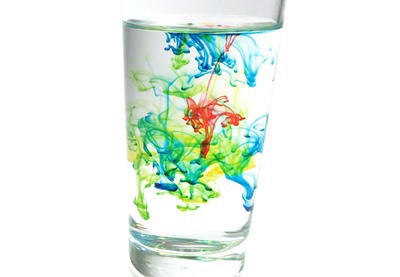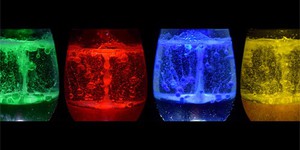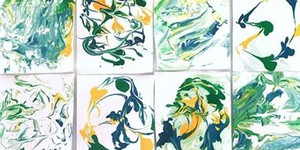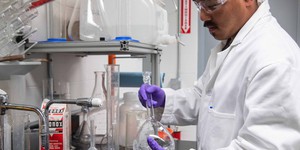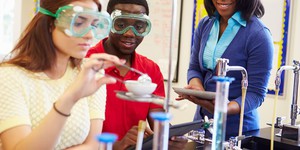Summary
Introduction
Summertime often brings beautiful fireworks displays. Whereas you normally look up into the sky to see fireworks, in this activity we will take the bursts of color underwater—with chemistry. Although it is not exactly the same as real fireworks, you will be amazed by the color explosions you will see. Curious about what that looks like? See for yourself in this activity!
Materials
- Transparent cups or glasses (2)
- Cooking oil (about 1 cup)
- Water (about 1 cup)
- Fork
- Spoon
- Food coloring (any color)
- Medicine dropper or pipette
- Small bowls (2)
- Tablespoon
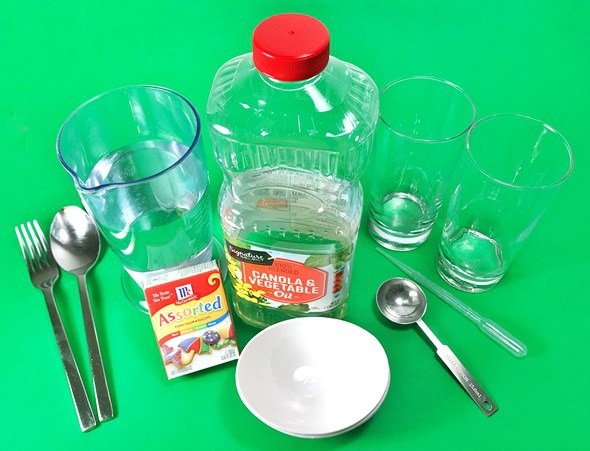 Image Credit: Svenja Lohner, Science Buddies / Science Buddies
Image Credit: Svenja Lohner, Science Buddies / Science Buddies
Prep Work
- Find a work area that can tolerate water and oil spills.
- Fill one of the cups with room temperature water.
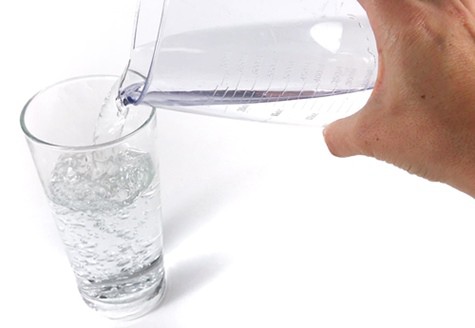 Image Credit: Svenja Lohner, Science Buddies / Science Buddies
Image Credit: Svenja Lohner, Science Buddies / Science Buddies
- Fill the other cup with oil.
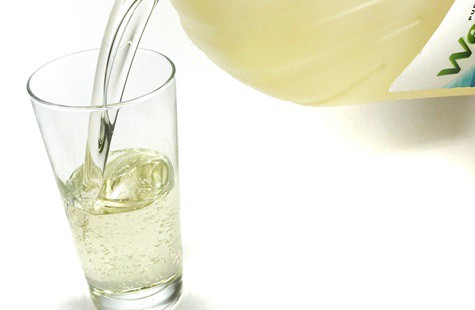 Image Credit: Svenja Lohner, Science Buddies / Science Buddies
Image Credit: Svenja Lohner, Science Buddies / Science Buddies
Instructions
- Into one of the small bowls, add one tablespoon of oil and 10-20 drops of food coloring. Mix both liquids with the fork.How does the liquid look after you mix both solutions? Do both liquids mix?
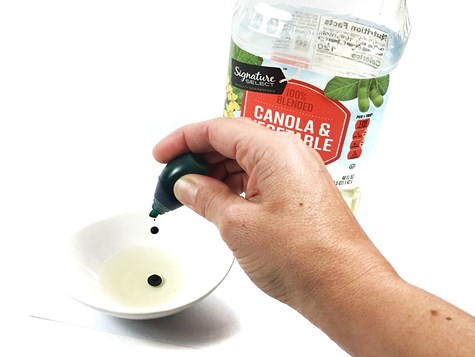 Image Credit: Svenja Lohner, Science Buddies / Science Buddies
Image Credit: Svenja Lohner, Science Buddies / Science Buddies
- Take the glass of water and place it next to the small bowl. Suck up some of the oil-food coloring mixture with a medical dropper or pipette, and carefully put one drop into the glass of water.What happens with the drop when it falls into the water? Does the drop float on top or sink to the bottom of the glass?
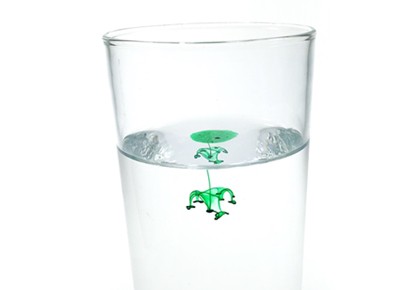 Image Credit: Svenja Lohner, Science Buddies / Science Buddies
Image Credit: Svenja Lohner, Science Buddies / Science Buddies
- Add more drops of the mixture to the water drop by drop.Does the food coloring change the color of the water? How does it look? How long does it take for the water to completely change color?
- Mix the contents of the water glass with a spoon or fork.Does the solution look different after mixing?
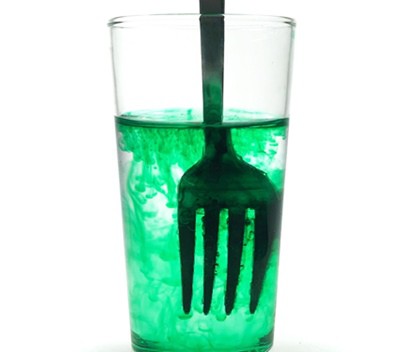 Image Credit: Svenja Lohner, Science Buddies / Science Buddies
Image Credit: Svenja Lohner, Science Buddies / Science Buddies
- Into the second small bowl, add one tablespoon of water and 10-20 drops of food coloring. Again, mix both liquids with a fork.How does this solution look after mixing? Are both liquids miscible?
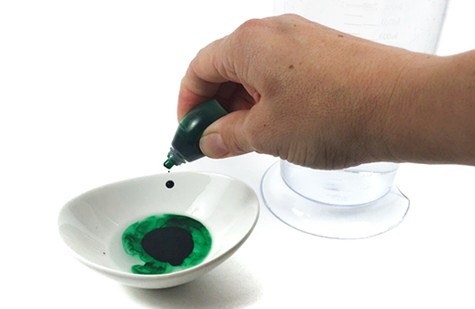 Image Credit: Svenja Lohner, Science Buddies / Science Buddies
Image Credit: Svenja Lohner, Science Buddies / Science Buddies
- Take the glass of oil and place it next to the small bowl. Suck up some of the water-food coloring mixture with the rinsed and cleaned dropper or pipette, and carefully put one drop into the oil.What happens to the drop this time? Does it float or sink?
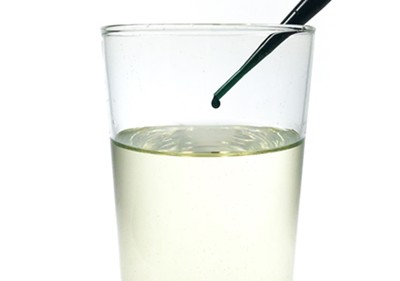 Image Credit: Svenja Lohner, Science Buddies / Science Buddies
Image Credit: Svenja Lohner, Science Buddies / Science Buddies
- Add more of the water-food coloring liquid to the oil drop by drop.Does the oil change color due to the food coloring? How does the mixture look?
- Finally, mix the contents of the oil glass with a spoon or fork.How does the solution look different after mixing?
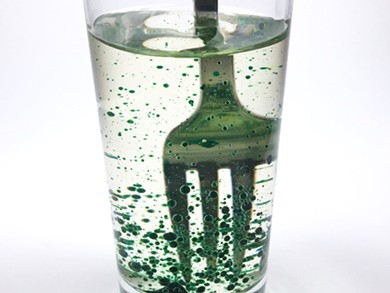 Image Credit: Svenja Lohner, Science Buddies / Science Buddies
Image Credit: Svenja Lohner, Science Buddies / Science Buddies
Cleanup
What Happened?
As you probably experienced, oil and food coloring do not mix well. This is because food coloring is a polar liquid, but oil is a nonpolar liquid. If you mix the two, you will see lots of little food coloring drops dispersed in the oil, but both liquids do not mix. When you add this mixture to the water in the glass, again, the oil will not mix with water, as this is also a polar substance. The oil will form a separate layer on top of the water, as oil is less dense (or lighter) than water. The food coloring, which is also heavier than oil and able to mix with water, sinks to the bottom of the oil drop or layer. As soon as it reaches the oil/water interface, it will start mixing with the water molecules through a process called diffusion.
That means that the food coloring molecules move from a high concentration of food coloring to a lower concentration of food coloring inside the water. This is why you do not see all of the water changing color immediately, but a slow mixing of both with some parts of the water still clear and others becoming colored. These color bursts and food coloring trails within the water might have reminded you of fireworks exploding in the sky and slowly falling to the ground. When you mix the solution with a fork or spoon, all of the food coloring molecules are spread equally within the water and the whole solution becomes colored.
On the other hand, if you mix the food coloring with the water, both liquids will mix immediately. When you add a drop of this mixture into the glass of oil, you should have noticed that the drop sinks all the way to the bottom of the glass, as water is denser than oil. At the same time, the food coloring stays mixed with the water, but does not mix with the oil. Even when you mix the solution with a spoon or fork, both liquids stay separated. You used this effect to make your own lava lamp when you did the extra activity!
Digging Deeper
You probably know the saying "oil and water do not mix," which is true. But why is that so? Some liquids do mix to become a homogeneous mixture, while others do not. This depends on their miscibility. Whether a liquid mixes with another is dependent on their individual molecular structures. Molecules can be classified into polar and nonpolar molecules. When atoms come together to form a molecule, they share negatively-charged electrons in a chemical bond. Sometimes, one atom attracts the electrons more than the other atom does, which results in a slight separation of the charge into a positive and negative pole within the molecule, which is also called an electric dipole. When this happens, the molecule is usually a polar molecule. Molecules that have an equal charge balance are nonpolar molecules.
A simple rule, "like dissolves like," can tell you which liquids mix or not. This means that liquids with similar polarity are miscible, whereas liquids with different polarities do not mix. Water is a polar liquid, which means its molecules have electric dipoles. On the other hand, oils are nonpolar, which is why they do not mix well with water. When liquids do not mix, they separate to build two separate layers on top of each other. Which layer is on top depends on the density of each liquid. The density is a measure of mass per unit of volume, which means that the heavier liquid will sink to the bottom and the lighter one will float on top.
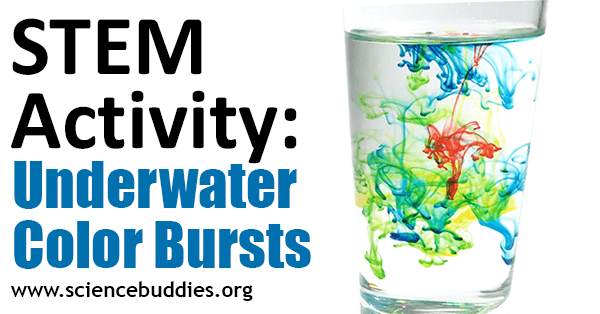 Image Credit: Science Buddies
Image Credit: Science Buddies
Ask an Expert
For Further Exploration
- To create some more diverse color explosions, mix a range of food coloring colors with oil in a small bowl. Then mix the food coloring drops into the oil with a fork. Instead of using a dropper, this time, carefully pour the whole oil-food coloring mixture into the glass of water to create multiple color explosions under water. What happens with the oil-food coloring mixture in the glass of water? Can you see the underwater color explosions? How does it look similar to real fireworks?
- Turn this activity into a homemade lava lamp! Use an empty one- or two-liter plastic bottle and fill it with about two inches of water. Add a couple of drops of food coloring and fill the bottle with vegetable oil. Then add about one quarter of an Alka-Seltzer® tablet. What happens to the oil and food coloring when you add the Alka-Seltzer tablet?
- Instead of using water and oil, try to mix food coloring and oil with other liquids. What do you think happens when you add a mixture of oil and food coloring to another liquid such as 50% isopropyl alcohol? Does the oil or food coloring mix with the alcohol? Do you see any separation of liquids into layers?
Related Resources
Activities
Links
- Sciencing: How to Explain Polarity
- Sciencing: Examples of Immiscible Liquids
- Ducksters: Chemistry for Kids: Solutions and Dissolving


